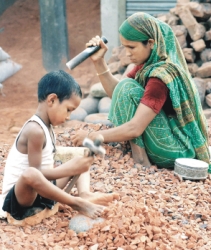Rights Corner
Status of child labour
In Bangladesh around 55 million people are considered to below the poverty line. As it is with most child labor, the primary cause for it in Bangladesh is poverty. For many, forcing their children to work is the only way to survive. Education is also hard to get to. Even if a family can afford to feed their children, they may not be able to afford education, which, though free until 5th grade, has the cost of transportation and uniforms.
In recent years child labour in Bangladesh has increased alarmingly. Traditionally, many children have always worked in village agriculture, but the numbers employed in urban industrial, commercial sectors and household has risen sharply. Working children are a neglected group in Bangladeshi society. They are seen as part of the floating population and are not included in the national census.
 Laws in Bangladesh do not restrict the employment of children in all kinds of industry except where the nature of work is very strenuous. In Bangladesh, urban working children either live on the street or in overcrowded slum and squatter settlements. According to a survey there are 400,000 children under the age of 15 working in urban areas, which is 12 per cent of the total urban labour force. They work in industry, transport, commerce, domestic service, metal & leather factories and construction and in garment factories. In spite of domestic and international laws and Conventions in favour of children, they can be found working in garment factories, hotels, brick making, biri factories, mechanical workshops, match factories, agricultural work, domestic work, and as garbage collectors and touts on buses and tampos. Children also work in small shops, tea stalls, handloom and bin' factories and the fishing industry. Most working children do not have the opportunity to attend school.
Laws in Bangladesh do not restrict the employment of children in all kinds of industry except where the nature of work is very strenuous. In Bangladesh, urban working children either live on the street or in overcrowded slum and squatter settlements. According to a survey there are 400,000 children under the age of 15 working in urban areas, which is 12 per cent of the total urban labour force. They work in industry, transport, commerce, domestic service, metal & leather factories and construction and in garment factories. In spite of domestic and international laws and Conventions in favour of children, they can be found working in garment factories, hotels, brick making, biri factories, mechanical workshops, match factories, agricultural work, domestic work, and as garbage collectors and touts on buses and tampos. Children also work in small shops, tea stalls, handloom and bin' factories and the fishing industry. Most working children do not have the opportunity to attend school.
Laws relating to child labour
In practice, child labour laws in Bangladesh do not protect working children. Employers prefer children, as they are cheap, productive and obedient. Children working in the industrial sector have no contract of employment and so find it difficult to stand up for them and fight for their rights. The demand by factories for child labourers is increasing all the time.
Working children are used and exploited for the benefit of the better-off sector of society. This is not really deliberate exploitation of children by the wealthy, but rather reflects the attitude of society, of children as a source of cheap labour. Child workers are always faced with bad working conditions, unfixed wages, health hazards, lack of recreation and are exposed to mental, physical and sexual harassment.
Child labour is prohibited in Bangladesh under the Employment of Children Act, 1938; The Children (Pledging of Labour) Act, 1933; The Factories Act, 1965; The Plantations Labour Ordinance, 1962 and The Shops and Establishment Act, 1965. All these laws prohibit the employment of children below 14 years of age.
In Bangladesh, children work because they and their families are poor and so there is no immediate prospect of eliminating child labour. But that does not mean that nothing can be done. The priority must be to ensure that children are excluded from dangerous and physically demanding work. Children are the future leaders of our nation. By neglecting their basic rights and hampering their process of growth, we are restricting the development of our country. However, progress is being made to eliminate child labor in Bangladesh.
Source: Shishuprakash, an initiative of Mass Line Media Centre and UNICEF.